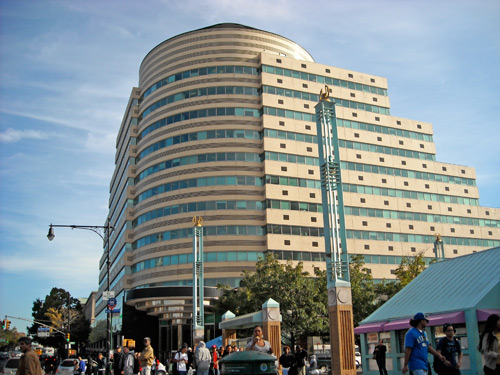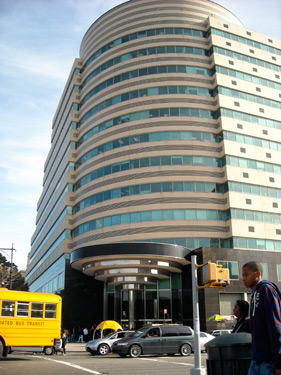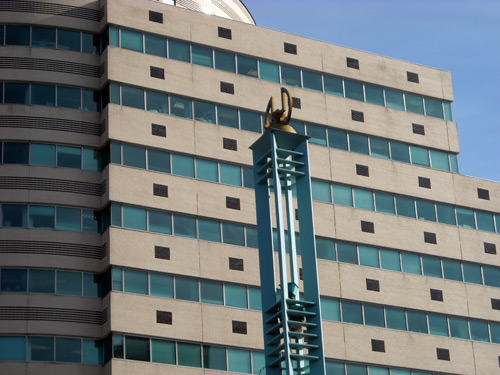Fordham Plaza

One Fordham Plaza
Skidmore, Owings and Merrill
1986
Built in 1986 at a cost of 60 million dollars, One Fordham Plaza was the largest office building to be erected in the Bronx for thirty years. The building is placed on a southeast corner at an important focus, where Third and Park venues converge and end at Fordham Road in a bus terminus, pedestrian mall, and Metro North station.
A “post-modern” work, One Fordham Plaza plays with intentionally oversimplified geometrical forms, eye-catching colors and surfaces, and architectural references.
In plan, the fourteen-story structure forms L. Wings with flat facades approaching the corner from south and east, stepping up from street level in two-floor intervals. Where they should meet, a broad cylindrical tower intervenes, the top of which continues the ziggurat pattern in a low pyramid of three thick concentric disks.
The building is made of glazed cream brick, ornamented with thin courses of black (on the tower) and repeating black rectangles (along the wings). Strip windows, recessed in the wall surface, girdle the building. The first two stories are clad in a contrasting sheet of polished black granite, running beneath the black circular canopy at the base of the tower. That canopy is supported by a single chrome column, the capital of which repeats, in inversion, the three-disk motif of the tower.
Stepwise outlines and glazed masonry are perhaps reminders of Babylonian temple architecture; the summit of stacked disks might be intended to recall the Mausoleum of Halicarnassas, as interpreted on Grant’s Tomb. However, consistent with the aesthetic of Michael Graves, Philip Johnson, and other post-modernists, these historical references seem intentionally superficial. Taken seriously, the symbolism of a Mausoleum or Tower of Babel might be unwelcome to the directors of the Fordham Business Improvement district.
It’s curious to find Skidmore, Owings and Merrill, who famously established the “Glass Box” as the architectural style of corporate America, experimenting at Fordham with the allusions and irony of Post-Modernism. But 1986 seems to have been a vintage year for this kind of playfulness. SOM was building the striped, polished-stone colonnades of Manhattan’s Worldwide Plaza, and Philip Johnson had completed his “Lipstick Building” in midtown, which like One Fordham Plaza erects a set of diminishing cylinders.
If there is a relevant architectural tradition to which the building can be attached, it is the Art Deco of the last century, fascinated with ziggurats (upright and inverted), geometric simplification, and patterned surfaces. The famous glazed-brick apartment houses of the Grand Concourse, a few blocks away from Fordham Plaza, are the local relatives who will vouch for this unexpected eccentric.
David Bady
Photographs:
Abigail McQuade


